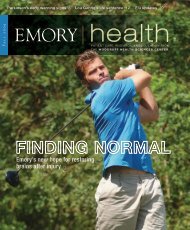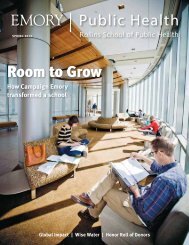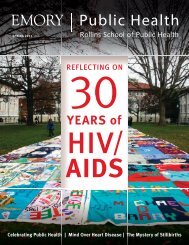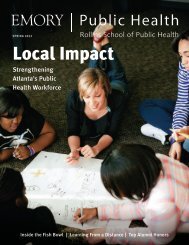returning quality to life - Woodruff Health Sciences Center - Emory ...
returning quality to life - Woodruff Health Sciences Center - Emory ...
returning quality to life - Woodruff Health Sciences Center - Emory ...
You also want an ePaper? Increase the reach of your titles
YUMPU automatically turns print PDFs into web optimized ePapers that Google loves.
FEATURE SAVING LIVES WORLDWIDE<br />
10<br />
EMORY HEALTH<br />
animals but which they excrete in saliva and<br />
urine.<br />
A low-tech, low-cost solution proved<br />
simple and sustainable. Villagers learned <strong>to</strong><br />
cover collection buckets with bamboo strips<br />
<strong>to</strong> keep bats away from the juice. They also<br />
learned how <strong>to</strong> take precautions against<br />
human-<strong>to</strong>-human transmission, which the<br />
scientists found <strong>to</strong> be responsible for several<br />
deaths. Nipah still appears every December,<br />
but the IEDCR is increasingly prepared <strong>to</strong><br />
recognize and respond <strong>to</strong> it.<br />
The Bangladesh institute got the jump<br />
start it needed for a stronger public health<br />
infrastructure from the International<br />
Association of National Public <strong>Health</strong><br />
Institutes (IANPHI). Pronounced I–AN–fee,<br />
the organization has secretariats in Atlanta<br />
and Finland at <strong>Emory</strong>’s Global <strong>Health</strong><br />
Institute and Finland’s National Institute<br />
for <strong>Health</strong> and Welfare. Its emphasis is on<br />
infrastructure: building and strengthening<br />
CDC-like institutes in low-resource countries,<br />
which can provide a local, systematic<br />
approach <strong>to</strong> disease surveillance, outbreak<br />
investigation and response, evidence–based<br />
policies and programs, and education and<br />
health promotion.<br />
In Bangladesh, the model is working,<br />
with the IEDCR able <strong>to</strong> mount a better<br />
response <strong>to</strong> outbreaks of diseases ranging<br />
from Nipah and cholera <strong>to</strong> puffer fish<br />
poisoning. Disease surveillance systems there<br />
are now more capable of detecting emerging<br />
and reemerging infections. With a more<br />
sophisticated labora<strong>to</strong>ry in-country, tests<br />
no longer have <strong>to</strong> be sent <strong>to</strong> the CDC but<br />
can be conducted overnight at home. A new<br />
BioSafety Level 3 lab, capable of dealing with<br />
serious air-borne infectious agents, enabled<br />
Bangladesh <strong>to</strong> quickly diagnose its first<br />
case of H1N1 and join the global influenza<br />
surveillance network.<br />
But the full power of Bangladesh’s<br />
stronger public health structure became<br />
evident during a recent outbreak of<br />
cutaneous anthrax in people there. Its<br />
surveillance system quickly noted the<br />
outbreaks, and its labora<strong>to</strong>ry was able <strong>to</strong><br />
pinpoint the bacterium. With a diagnosis<br />
in hand, the government provided free and<br />
prompt antibiotic treatment, while teams of<br />
epidemiologists went door-<strong>to</strong>-door, tracking<br />
how people had been exposed.<br />
The detective work paid off. Anthrax<br />
primarily affects cattle and other herbivorous<br />
“What we want <strong>to</strong> show the world now is that it is<br />
possible, even in very poor countries, even in the<br />
most adverse situations, <strong>to</strong> develop a good <strong>quality</strong><br />
public health system.” —Amabelia Rodrigues<br />
animals, killing them quickly but not before<br />
they shed millions of bacteria. A dying<br />
cow’s owner may be tempted <strong>to</strong> slaughter<br />
it for meat, hoping <strong>to</strong> partially compensate<br />
himself for the loss of income. In one village,<br />
the slaughter of a single sick cow affected<br />
42 people, including many small children.<br />
In another, a dead cow was thrown in<strong>to</strong><br />
a riverbed instead of the recommended<br />
procedure of burying it six feet deep.<br />
After scientists identified the source of<br />
infection, local officials wheeled rickshaws<br />
with loudspeakers through villages <strong>to</strong><br />
broadcast the public health message: Protect<br />
against anthrax. Seek treatment for sick<br />
cows. Don’t slaughter them. Dispose of<br />
dead animals properly. Public health leaders<br />
worked with village leaders and the media <strong>to</strong><br />
turn up social pressure about handling sick<br />
or dead cattle, and the IEDCR updated its<br />
website everyday at noon.<br />
Direc<strong>to</strong>r Mahmudur Rahman and his<br />
team believe that the impact of their stronger<br />
public health infrastructure will only<br />
continue <strong>to</strong> grow, multiplying the momentum<br />
of public health success in Bangladesh. EH
















